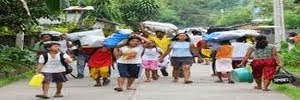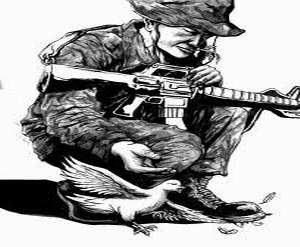
From the Website of DSWD
links: http://www.dswd.gov.ph/2014/11/yolanda-made-samar-community-stronger-wiser-through-dswd-program/
Typhoon Yolanda stories can be depressing, given the level of devastation it brought to the country.
Barangay Inobangan in San Sebastian, Samar, however, is a different case.
Even though it was also hit by ‘Yolanda’ a year ago on November 8, 2013, the residents did not allow the disaster to overwhelm them. Instead, they used it as a springboard to grow stronger as a community, with the help of Kapit-Bisig Laban sa Kahirapan-Comprehensive and Integrated Delivery of Social Services (Kalahi-CIDSS), one of the programs of the Department of Social Welfare and Development (DSWD), in partnership with the Millennium Challenge Account (MCC).
Looking at the face of defeat
After ‘Yolanda’, prices of construction materials skyrocketed, given the high demand for these because of the large-scale repairs and infrastructure recovery works that needed to be done following the disaster.
This was the situation the people of San Sebastian found themselves facing. Implementing a 0.7-km path walk as a government-funded sub-project through Kalahi-CIDSS did not stop their previously contracted supplier from backing out because its stocks ran out.
The Procurement Team volunteers, led by Mario Vinceto, 42, nearly gave up. Canvassing failed several times, almost leading to the volunteer Procurement Team to surrender.
“May times na gusto na naming sumuko (There were times when we wanted to give up)”, said Mario.
They were eventually able to find suppliers, but only by January 2014, two months after ‘Yolanda’.
Still, the experience produced a lot of good. Since they have had prior experience in Kalahi-CIDSS, having implemented it the previous year, they were able to further develop their procurement skills. The barangay is now looking into formally adopting the procurement system of Kalahi-CIDSS as they now want to increase the involvement of residents.
The residents also became more confident in their skills in identifying quality in the materials and actual construction of sub-projects, even those that are not under Kalahi-CIDSS.
Antonieta Abaygar, 58, who served as the Barangay Sub-Project Management Chairperson (BSPMC) for their path walk sub-project, said that people are now more confident and stringent about standards of sub-projects.
She shared, “May nakita ang isang volunteer na na-damage ang kalsada. Agad sinabing nasira ang kalsada. Magkaka-findings iyang supplier. Kung Kalahi-CIDSS iyan, blacklisted na iyan (One of the volunteers saw part of the road was damaged. He said that the road is damaged. There will be findings on the supplier. If this was a Kalahi-CIDSS sub-project, the supplier would already be blacklisted).”
Employment
Residents also gained other things in their involvement in Kalahi-CIDSS.
For instance, women were able to earn as laborers during the construction of their path walk. This was something new for them, as it was more common among them to stay at home instead of work, let alone in construction.
Priscilla Jabonete, 41, who served as one of the laborers, said, “Dati, lalaki lang ang nag-le-labor. Ngayon, diri na… Ang mga babae, puwede na magtrabaho ayon sa kakayanan (Men were the only ones who did construction work before. This is no longer the case. Women can now work based on skill).”
They got the same salary as the men at P210 per day, which they used to help support their families.
Elita Pacayra, 25, and a mother of two said, “Okay ang trabaho kasi nakakadagdag kita para sa pamilya (The work is good because it helps us earn for our families),” adding that she uses the money to buy food for her family.
The job opportunities for women in Barangay Inobangan through KALAHI-CIDSS-MCC will not end there. Earlier this year, the barangay was one of the communities awarded a Gender Incentive Grant (GIG), also through the partnership project.
Through the GIG, interested women can be provided skills trainings in construction work such as welding, plumbing, electricity, masonry, and carpentry.
As a barangay of a 6th class municipality with 57 Pantawid Pamilyang Pilipino Program partner-beneficiaries, the job generation as a result of the trainings will be a big help to these poor families.
More economic opportunities
The path walk itself will lead to greater economic opportunities for the villagers.
Inobangan is primarily a farming community, with 77 of its 108 households involved in this industry. Before the path walk was constructed, farmers had to hire porters to help them bring their crops to the market, at P20 per sack, an already sizeable sum considering the meager earnings they get.
To make matters even more difficult for the farmers, even a little bit of rain makes the path muddy, making it difficult and dangerous for them to traverse the path, especially if they have their crops with them.
With the construction of the path walk, traveling to and from their farms will now be safer and quicker, and they will be able to use the money they previously spent on hiring porters to buy more seeds, put food on the table, and support their children.
Residents from neighboring barangays such as Balugo and Osmeña will also benefit from the path walk, as they can also use it to get to and from their villages and their farms.
Working in the sub-project also made the residents have more ownership of this, pushing them to take good care of it.
Said Priscilla, “Kami ang nag-trabaho diyan. May share kami diyan (We were the ones who worked for that, so we have a share in that).”
According to the Inobangan residents, volunteering in Kalahi-CIDSS helped tie the community closer together.
Barangay Captain Wilma Abaygar, 41, said, “Ang Kalahi-CIDSS ay pakikipagtulungan, kapit-bisig (Kalahi-CIDSS is about helping, linking arms with each other).”
Barangay Inobangan proved that even a disaster as strong as ‘Yolanda’ will not be able to break their spirits as long as they work together as a community.
As Barangay Captain Wilma Abaygar said, “Dati, walang pakialam ang mga tao, lalo na para sa kabilang-barangay. Nagkaroon lang ng ganyan sa Kalahi-CIDSS (People did not care before, especially for other barangays. This only happened as a result of Kalahi-CIDSS).”
Community-driven
Kalahi-CIDSS is a DSWD program that seeks to help alleviate poverty through community-driven development.
KALAHI CIDSS-NCDDP is the expansion into a national scale of operations of the CDD approach, which was tried and proven effective by Kalahi-CIDSS. It targets the coverage of 847 of the poorest municipalities in the country.
The Millennium Challenge Corporation (MCC) is an independent U.S. foreign aid agency created in 2004 to help achieve the Millennium Development Goals by helping countries promote economic growth. ### - See more at: http://www.dswd.gov.ph/2014/11/yolanda-made-samar-community-stronger-wiser-through-dswd-program/#sthash.lv9dVCun.dpuf
DSWD Website
http://www.dswd.gov.ph/
Article Links
http://www.dswd.gov.ph/2014/09/pantawid-pamilya-model-family-a-blessing-to-their-community/
OTHER HUMAN RIGHTS PROMOTIONS WEBSITES
Human Rights Advocacy Promotions | Human Rights
Home - Human rights Promotions Website
HUMAN RIGHTS PROMOTIONS
PROTECTION AND PROMOTION OF HUMAN RIGHTS
-----------------------------------------------------------------------------------------------
------------------------------------------------------------
-----------------------------
http://www.dswd.gov.ph/
Article Links
http://www.dswd.gov.ph/2014/09/pantawid-pamilya-model-family-a-blessing-to-their-community/
OTHER HUMAN RIGHTS PROMOTIONS WEBSITES
Human Rights Advocacy Promotions | Human Rights
Home - Human rights Promotions Website
HUMAN RIGHTS PROMOTIONS
PROTECTION AND PROMOTION OF HUMAN RIGHTS
-----------------------------------------------------------------------------------------------
------------------------------------------------------------
-----------------------------
























0 comments:
Post a Comment